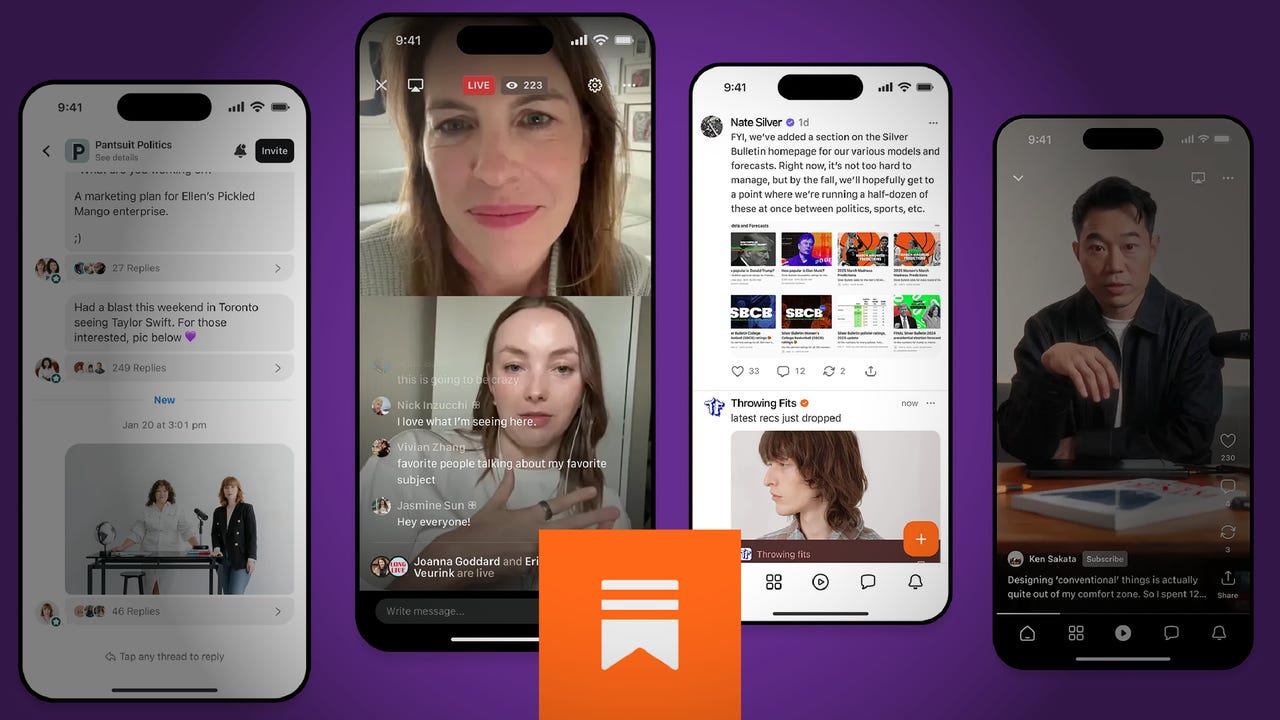Substack Isn’t Just for Creators: Tips and Considerations for B2B and B2C BrandsSubstack Isn’t Just for Creators: Tips and Considerations for B2B and B2C Brands
Substack, initially a newsletter platform for creators, now attracts over 5 million paid subscriptions. Explore what marketers should know about getting their brands into the mix, including lessons from the CMO of American Eagle.
July 1, 2025

Have you paid attention to the rise of Substack newsletters?
There are more than 5 million paid subscriptions on the platform, a 67% jump in less than a year, according to the company, and millions more sign up for free subscriptions.
With those numbers, what marketer’s interest wouldn't be piqued by the self-publishing media outlet?
To help you explore the potential for your brand, we went directly to the source, getting insight from Substack and asking questions of the chief marketing officer of American Eagle, which recently debuted a newsletter on the platform.
Isn't Substack just a platform for solo creators?
In 2017, Substack was created for individual creators to publish and distribute newsletters for free and/or charge subscription fees. In subsequent years, it added podcast and video distribution, plus chats and conversation thread features. In 2022, it launched the Substack app, which the company says attracts 1 million post discoveries every day.
Creators set their subscription rates; Substack keeps 10% of subscription revenue . (Creators also incur credit card fees of 2.9% plus 30 cents.)
Substack subscribers can provide their email address (and payment information) to regularly receive the free and paid versions. However, some Substack creators allow platform visitors to consume some content without providing an email address.
Substack says more than 50,000 newsletter publishers make money on the platform, with the top 10 collectively earning more than $40 million a year.
So, Substack is certainly designed for solo creators, but its explosive audience growth has attracted the attention of forward-thinking brands.
Why did American Eagle launch a newsletter?
In an email interview with CMI, Craig Brommers, chief marketing officer at American Eagle, shares the story behind the retail brand’s decision to launch a Substack newsletter.
It starts with Gen Z. Reaching that target audience often requires American Eagle to look ahead. “We’ve had success being early adopters of platforms like BeReal (social media platform), Roblox (gaming), Lemon8 (social media app), and so many more. We see Substack as another way to meet our audience where they’re headed, not just where they are,” Craig says.
The newsletter, Off the Cuff by American Eagle, allows the brand “to slow down, go deeper, and share a different side of AE — one that’s more conversational and culturally tuned in,” Craig says.
The free biweekly newsletter describes itself as “a cultural and style digest ... blending guest editors and AE’s perspective to spotlight what’s shaping fashion, media, and youth culture today.”

Within six weeks of its debut, Off the Cuff gained more than 2,000 Substack subscribers.
Yes, American Eagle talks “a little bit of denim” in the newsletter, but it primarily uses the space like a cool group chat. “The goal isn’t transactional. It’s about building brand love and showing up in ways that reflect how our audience actually lives and thinks,” Craig says.
The Substack newsletter isn’t a replacement for American Eagle’s TikTok and Instagram channels, which remain important to the brand. Instead, it creates a layer of content that goes beyond the scroll.
How does the work get done?
For the debut issue, American Eagle partnered with Casey Lewis, author of After School, which ranks No. 21 in Substack’s Best Seller list for the Culture category with over 76,000 subscribers.
The guest writer not only has her “finger on the pulse of youth culture in a way that’s real and unfiltered,” but she knows the Substack platform and audience.
“Casey brought real credibility and a sharp editorial voice that doesn’t feel overly branded, which are key priorities for us,” Craig explains. “We know what we’re great at, and we also know when to bring in people who can add more dimension.”
So, the American Eagle marketing team manages the newsletter content and, at times, works with guest editors who have their own voice, lens, and followings. "The rotating contributor model gives us a chance to keep evolving the conversation and build something dynamic, not static,” Craig says.
How do other brands use Substack?
“Many brands are joining organically as they recognize the value of showing up with more intention and authenticity,” a Substack spokesperson tells us in an email interview.
They share that American Eagle, Hinge, and Rare Beauty, among other brands, find success publishing on Substack because they lean into the storytelling, editorial voice, and community engagement necessary to build trust and connection beyond traditional marketing.
Let’s look closer at Hinge and Rare Beauty’s Substack content.
Hinge: No Ordinary Love
Dating app Hinge published a five-part literary series, No Ordinary Love, on Substack. It partnered with writers like Upasna Barath, who has her own Substack newsletter, to tell masterful stories that quickly bring readers into the (potential) romance of Hinge clients.
Upasna’s story tells how Jerome and Tyla opened themselves up to love’s first and second chances (screenshot below).

“This series reflects Hinge’s broader effort to connect with audiences through storytelling and building trust through intimate, narrative-driven content,” Substack’s spokesperson says.
Rare Beauty: Rare Beauty Secrets
Since April, the Rare Beauty cosmetics brand, founded by Selena Gomez, has published a weekly newsletter that brings readers behind the scenes (that’s the “secrets” part). It might publish an article revealing an employee’s insight, a story about prepping for a magazine shoot, or an interview from its Rare Beauty Mental Health Summit.
This screenshot of its home page gives a glimpse at the content lineup:
It’s OK to Disappoint Your Parents ... And other things I learned from our director of social impact
How the Brow Gel is Made ... Our chief product officer gave us months to make it happen
A REAL Office Tour ... What you didn’t see in the glossy magazine
Feeling Inspired: ’80s Blush ... Beauty lessons from the past
Makeup Isn’t Made for Everyone ... But Tara Sigari thinks it should be (and we agree)

Rare Beauty also shapes the behind-the-scenes content around the questions posed by its community. “It reflects the company’s values versus promoting product,” a Substack spokesperson says.
Substack tips for B2B and B2C brands
A successful Substack strategy requires brands to embrace a content marketing philosophy and forgo promotional content. “Success comes from bringing a strong, original perspective,” Substack’s spokesperson shares.
Follow these six steps to consider and master a Substack presence for your brand:
1. Do audience research
See if your target audience uses the platform. Yes, Gen Z is a go-to group for Substack. But it also works well for other audiences or niche topics.
Explore the platform to see if newsletters targeting similar audiences or topics exist. Track the newsletter names, subscriber counts, and subtopics. That research will help you understand if your audience is there. It can also help identify content gaps that your brand could fill on the platform.
2. Build your brand presence
If Substack is a good audience fit, the next step is to consider these branding options:
Use your brand name, like American Eagle, Hinge, and Rare Beauty did.
Use the personal brand of a founder, executive, or other public-facing personality in the organization.
“Having a founder or a personality behind the brand who can share their story and more about their life will always be a compelling way to show up,” a Substack spokesperson says.
They point to Katie Elliott, vice president of design at lighting and lifestyle brand Schoolhouse, as an example. The company launched Design School, a weekly update from Katie on the ideas and inspirations that fuel her creativity.
Non-alcoholic apéritif brand Ghia’s founder, Melanie Masarin, has a Substack called Night Shade. She shares posts about her life and thoughts.
Unless your brand name already has an audience deeply eager for your content, it may make sense to follow the more traditional Substack formula and pick an individual to “author” the newsletter. However, to ensure brand continuity (and audience retention) if the author leaves the company, don’t use their name in the newsletter title or the Substack URL.
3. Create unique content
As for the content itself, don’t treat Substack as just another distribution platform. To build a subscribed audience, deliver content that people can’t find on other channels. Use your social media and other owned channels to promote the Substack newsletter, not republish its content.
That’s why behind-the-scenes content works well. It allows you to tell a story that takes your audience deeper into your brand and its processes. It also gives you the opportunity to ask your audience what they want to know about your brand, like Rare Beauty does.
4. Partner up
Consider content partnerships with Substack creators who already reach your audience, as American Eagle does. The cross-promotion opportunities can help spread awareness of your Substack newsletter and provide the credibility necessary to gain the trust (i.e., email addresses) of new subscribers.
5. Plan for imperfection
“If you’re going to show up on a new platform, you have to go in with an open mind and not be afraid to change things along the way, and even potentially fail. It’s about testing, learning, and trying something new,” Craig says.
6. Embrace the free
Finally, don’t think of Substack as a revenue source yet if ever.
American Eagle plans to keep the newsletter free. “Right now, we’re focused on access and value. We want Off The Cuff by American Eagle to feel organic and open, not gated or transactional,” Craig says.
Down the road, you may see the potential to turn the Substack newsletter into a revenue source through paid subscriptions. Just make sure you have the resources to continue supporting the free version and regularly deliver premium content, too.
More good Substack practices
Michelle Martello, founder of Minima Designs, offers a tip for Substack publishers — create a backup system by regularly downloading your subscriber email list from the platform.
Like many third-party platforms, Substack’s terms of use say it can remove content any time without notice and delete the account. While that’s unlikely, you don’t want to take the chance.
Email addresses are a real asset for brands on Substack. Having a direct connection to your audience affords opportunities that social media doesn’t allow.
Just remember to cultivate that asset by forging connections with your subscribers through content that speaks to them and their interests related to your brand and industry.
Like what you read here? Get yourself a subscription to daily or weekly updates. It’s free – and you can change your preferences or unsubscribe anytime.
HANDPICKED RELATED CONTENT:



